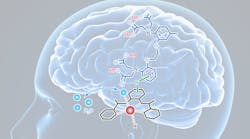Calcium is a critical signaling molecule for most cells, and it is especially important for letting neurons in the brain communicate with each other. Unfortunately, researchers can only “see” neurons a fraction of a millimeter into the brain using current methods. But a team of MIT researchers recently devised a new type of MRI that lets them see calcium activity much deeper into the brain. This new technique lets them track signaling processes inside neurons of living animals and link that neural activity with specific behaviors.
Resting neurons have low calcium levels. However, when they fire an electrical impulse, calcium floods into the cell. In the past, scientists monitored such calcium activity by tagging the calcium with fluorescent molecules and then imaging the fluorescence. The drawback was, this imaging method only penetrated a few tenths of a millimeter into the tissue, limiting most studies to the brain’s surface.
To look deeper, MIT researchers developed an MRI sensor that measures extracellular calcium concentrations, but these were based on nanoparticles too large to enter cells.
To create an intracellular calcium sensor, the researchers made a contrast agent that passes through cell membranes. The agent contains manganese, a metal that interacts weakly with magnetic fields, bound to an organic compound that penetrates cell membranes. The complex also contains a calcium-binding arm called a chelator.
Once inside the cell, if calcium levels are low, the calcium chelator binds weakly to the manganese atom, shielding the manganese from MRI detection. When calcium flows into the cell, the chelator binds to the calcium and releases the manganese, which makes the contrast agent appear brighter in MRI images.
When neurons, or other brain cells called glia, become stimulated, they often experience more than a tenfold increase in calcium concentration. The sensor can detect those changes.
The researchers tested their sensor in rats by injecting it into the striatum, a region deep within the brain that is involved in planning movement and learning new behaviors. They used potassium ions to stimulate electrical activity in the striatum’s neurons, and could measure the calcium response in those cells using MRI.
The researchers hope to use this technique to identify small clusters of neurons involved in specific behaviors or actions. Because this method directly measures signaling within cells, it offers much more precise information about the location and timing of neuron activity than traditional functional MRI (fMRI), which measures blood flow in the brain. This could be useful for determining how different structures in the brain collaborate to process stimuli or coordinate behavior.
In addition, this technique could be used to image calcium as it performs many other roles, such as helping activate immune cells. With further modification, it could also be used for diagnostic imaging of the brain or other organs whose functions rely on calcium, such as the heart.

